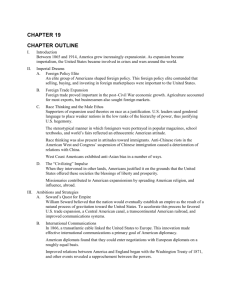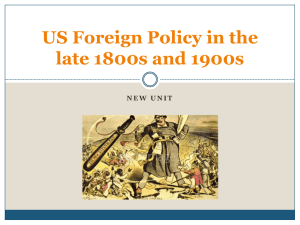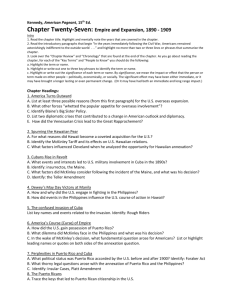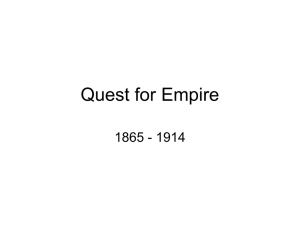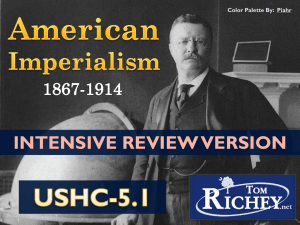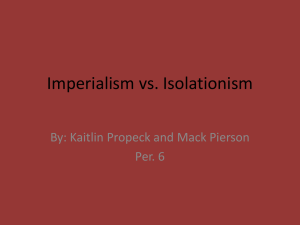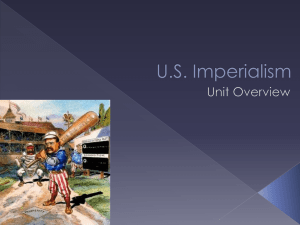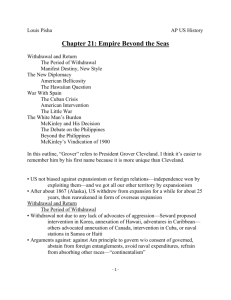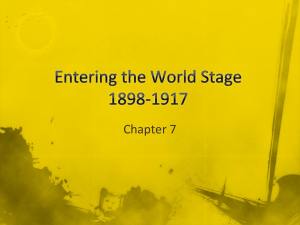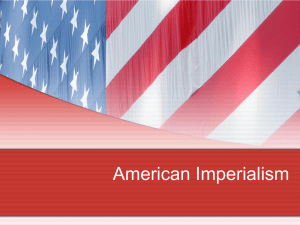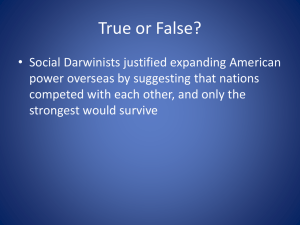Imperialism vs. Isolationism
advertisement
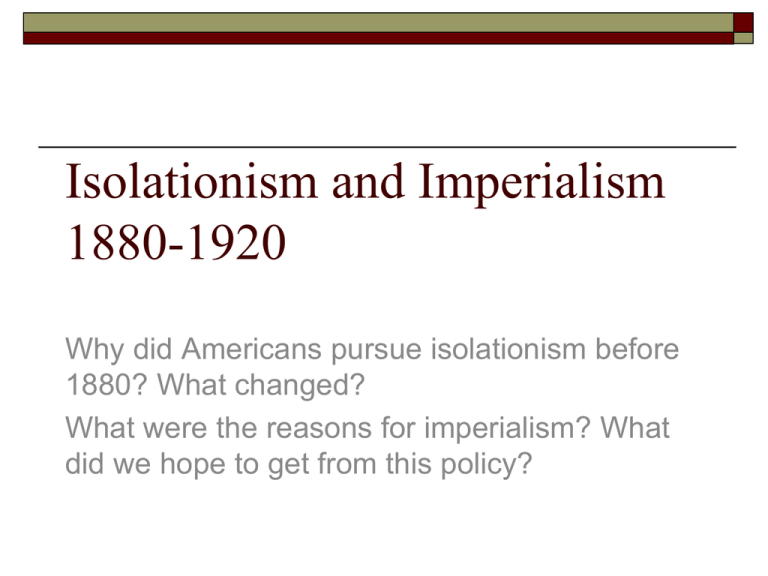
Isolationism and Imperialism 1880-1920 Why did Americans pursue isolationism before 1880? What changed? What were the reasons for imperialism? What did we hope to get from this policy? Isolationism Isolationism—official foreign policy of the U.S. until the late 19th century; belief that the nation should keep out of other nations’ affairs in order to develop and focus on domestic issues This belief began with Washington’s Farewell Address and outlined in the Monroe Doctrine Rationale for Isolationism -The rationale for isolationism was that it kept America safe and out of conflict. -It stemmed from fear of outsiders (xenophobia) and the harm that they could do to America. -Isolationism ensured America’s safety and kept it from being dragged into wars and entanglements that did not directly affect the nation. Imperialism Imperialism—policy in which stronger nations expand their economic, political, or military control over weaker territories. Started with U.S. desire to trade with other countries to create economic growth Expansionism—policy of “taking over” or gaining control of other countries America Claims an Empire Americans began to warm to the idea of expansion overseas due to three reasons: Desire for military strength Thirst for new markets (trade) Belief in cultural superiority Desire for Military Strength Alfred Thayer Mahan, an officer in the U.S. Navy, urged government officials to build up American naval power in his famous work, The Influence of Sea Power Upon History (1890) concept of “sea power” was based on the idea that countries with greater naval power will have greater worldwide impact European naval arms race began in the 1890s, which included the United States Attempt to gain more influence in foreign countries as protectorates and trading partners United States built nine steel-hulled cruisers between 1883 and 1890 became the world’s third largest naval power by 1900 New Markets & Cultural Superiority Advances in technology allowed farms and factories to produce more than Americans could consume. United States needed raw materials for its factories and new markets for its agricultural and manufactured goods. Foreign trade is the solution Some Americans believed in a racial superiority of the Anglo-Saxons (“whites”). Ideas of Social Darwinism Some believed the United States had a responsibility to spread Christianity and “civilization” to the world’s “inferior peoples.” especially in Africa (i.e., Joseph Conrad’s Heart of Darkness) Alaska (“Seward’s Folly”), 1867 William Seward, Secretary of State, arranged U.S. purchase of Alaska from Russia for $7.2 bil. (Russia wanted to avoid further war with Britain) Seward had trouble persuading the House of Representatives to fund the purchase—many believed it would cause conflict Idea changed with discovery of rich resources (timber, gold, minerals, oil) “PREPARING FOR THE HEATED TERM” “King Andy and his man Billy lay in a great stock of Russian ice in order to cool down the Congressional majority.” Annexation of Hawai’i (1893-1898) England had been a naval power for over 200 years at this point; when the U.S. looked to conquer new lands, much of the world had already been claimed. Only a few distant territories in Africa and Asia and remote islands in the Pacific remained free from imperial grasp; Hawaii was one such plum. Americans gained influence in Hawai’i as a result of the sugar trade 1867: U.S. took over the Midway Islands 1887: U.S. built naval base at Hawai’i’s best port, Pearl Harbor 1890: turning point in U.S.-Hawaiian relations when Congress approved the McKinley Tariff, which raised import rates on foreign sugar The tariff created a depression on the island. Sugar growers, mostly white Americans planned to have the U.S. annex Hawai’i in order to end the tariff on their goods. At the same time, the Hawai’ian throne was passed to Queen Liliuokalani, who was determined to end American influence on the island 1893: American business groups organized a revolution with the Marines and overthrew the queen They set up a new government headed by Sanford B. Dole, a prominent sugar plantation owner (later, founder of the Dole Fruit Company) Hawai’i President Cleveland did not support the revolution and ordered that the queen be returned to the throne. Dole refused to surrender so Cleveland recognized the Republic of Hawai’i but refused to annex the nation unless a majority of Hawaiians favored it. In 1897, pro-expansion President William McKinley succeeded Cleveland as president Following the Spanish-American War, McKinley and Congress proclaimed Hawaii an American territory on August 12, 1898 Spanish-American War (1898) The Spanish American war had a number of CAUSES: 1.) Trouble in Cuba – Spain’s treatment of Cuban citizens angered those in favor of national sovereignty 2.) Yellow Journalism – some reporters wanted to sell more newspapers so they made little problems seem far worse than they were! 3.) The explosion of the U.S.S. Maine off the coast of Havana, Cuba “Remember the Maine, to hell with Spain!” At the end of the SpanishAmerican War (“The Glorious Little War”), the U.S. gained territory, expanding its empire. After much fighting, the United States and Spain signed the Treaty of Paris (1898): Spain gives Puerto Rico and Guam to the U.S. Placed Cuba and Philippine Islands under U.S. rule Cuba -Although Cuba became free after the Spanish-American war, American troops continued to occupy the territory. -In 1901, the U.S. insisted that Cuba adopt the Platt Amendment which stated that the U.S. reserved the right to intervene in Cuba, Cuba was not to go into debt, the United States could buy or lease land for naval stations, and Cuba could not make treaties that might limit its independence. -Cuba then became a U.S. protectorate, a country whose affairs are partially controlled by a stronger power. Annexation of the Philippines Annexation—occupation and/or addition of another territory or country to a larger, more powerful country Much controversy arose because of the U.S. annexing the Philippines. Many people did not believe the U.S. had the right to interfere with or prevent Philippines’ independence McKinley justified the annexation of the Philippines by saying that it was “a gift from the gods” and that since “they were unfit for self-government, ... there was nothing left for us to do but to take them all, and to educate the Filipinos, and uplift and civilize and Christianize them” (already Christian for centuries) Philippine-American War Filipinos initially saw their relationship with U.S. as two nations joined in a common struggle against Spain However, U.S. wouldn’t commit to paper a statement of support for Philippine independence Filipinos were outraged by the Treaty of Paris and U.S. annexation War broke out in 1899, after two American soldiers killed three Filipino soldiers lasted for nearly 3 years at a cost of $400 million dollars and countless lives Philippines would not become independent until 1946 1898 political cartoon showing McKinley with a native child. Here, returning the Philippines to Spain is compared to throwing the child off a cliff. Puerto Rico & American Samoa After U.S. acquisition of the Caribbean island of Puerto Rico in the Treaty of Paris, many Puerto Ricans hoped for independence However, it was ruled by the U.S. military until 1900, when Congress passed the Foraker Act which ended military rule and set up a civil government. 1917: Puerto Ricans gain right to become U.S. citizens Samoa is a group of Pacific Islands known for their trading ports in the 1800s. As European and American expansionists hoped to gain territory, Samoa became a point of contention. The U.S. and Germany entered a naval battle in 1899 for control of the Samoan Islands, but were stopped when a storm sank most of the ships. U.S. and Germany divide the Islands into territories; U.S. owned territories become “American Samoa”, incorporated as a protectorate, and later a territory after the role American Samoa played in the American/Allied victory in World War II. China & Open Door Policy U.S. imperialists saw the Philippines as a gateway to the rest of Asia, especially China. China was potentially a vast market for American products However, six European nations had taken over small parts of China and forcibly controlling the people and trade in those areas (spheres of influence) As a result, China had become known as the “sick man of Asia.” U.S. Secretary of State, John Hay, wanted to protect American interests so he issued a series of policy statements called the Open Door Notes. These were letters to leaders of imperialist nations proposing that the nations share their trading rights with the U.S. (these were ignored by other nations) Thus, no single nation would have a monopoly on trade with any one part of China. Open Door Policy reflected American beliefs about U.S. industrialist capitalist economy: growth of the economy depended on exports U.S. had a right to intervene abroad to keep foreign markets open The closing of an area to American products or people threatened U.S. survival. Boxer Rebellion (1898-1901) Many Chinese were unhappy with the other countries being in China and started an uprising: the Boxer Rebellion. “Boxer” was a nickname given to the secret Chinese religious society, The Society of Righteous and Harmonious Fists The Boxers aimed to end the rule of foreign powers in China by training in martial arts, weaponry, and prayer This was quickly “crushed” by the countries involved in trade and occupation of China, including the U.S., Russia, Japan, Britain… After the Rebellion, the U.S. reaffirmed that trade between the U.S. and China would be open to all without compromising China’s sovereignty However, most of the other European powers continued to exploit China, and fought wars over control of trade (RussoJapanese War) Internal divisions in Chinese rulership also emerged, leading to a civil war in China Mexico A rebel group formed under a man named Francisco “Pancho” Villa. On his raids, Villa also killed Americans, prompting Wilson to send 15,000 troops into Mexico to capture Villa. In 1911, Mexican workers and peasants overthrew their military dictator. After 2 years, a new government was established, but President Wilson refused to recognize it, sending in Marines to occupy Veracruz. The countries were on the brink of war but both eventually backed down. This U.S. intervention provides a clear example of American imperialist attitudes of the time: no one was to intervene in U.S. affairs. The Huerta Regime collapsed and a new government was formed under Venustiano Carranza. While this government was accepted by the U.S., many Mexican citizens felt betrayed Video is here Rationale for Imperialism By 1900, the U.S. had gained a substantial empire and President McKinley, who was a confirmed imperialist, was reelected. Most believed that imperialism helped America to grow in size and thus become a stronger world power. However, some people such as Grover Cleveland and Andrew Carnegie did not support imperialism. They believed it was wrong for the United States to rule other people without their consent. World War I: “The Great War” By the beginning of World War I, the U.S. declared neutrality and took a strict noninvolvement stance on the war (return to isolationist policy). Why? Work Cited/Additional Resources Danzer, Gerald A., Jorge J. Klor De Alva, Larry S. Krieger, Louis E. Wilson, and Nancy Woloch. The Americans. California ed. Evanston: McDougal Littell, 2003. Print. Reconstruction to the 21st Century. American Imperialism: Crash Course in U.S. History (YouTube) http://youtu.be/QfsfoFqsFk4 Imperialism for Dummies part I and part II (HipHughes History—YouTube)
